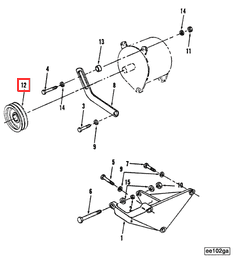This truck part is made by Cummins®. We guarantee that all of our parts are from the OEM (original equipment manufacturer), ensuring a proper fit and quality manufacturing.
We honor the warranty provided by the original equipment manufacturer.
The Cummins 201987 Alternator Pulley is a component designed for use in commercial trucks. Its purpose is to facilitate the operation of the alternator, which is responsible for generating electrical power to support various electrical systems within the vehicle. The significance of this pulley lies in its role in ensuring the alternator functions correctly, thereby maintaining the truck’s electrical systems and overall performance.
Basic Concepts of Alternator Pulleys
An alternator pulley is a mechanical component that connects the alternator to the engine’s crankshaft via a serpentine belt. Its function is to transfer rotational force from the engine to the alternator, enabling the alternator to generate electricity. The pulley works in conjunction with the serpentine belt, which wraps around it and other engine components, ensuring a synchronized operation that powers the vehicle’s electrical systems 1.
Purpose of the 201987 Alternator Pulley
This Cummins part plays a role in the operation of a truck by driving the alternator. This action generates electrical power that is used to charge the battery and power the truck’s electrical systems, including lights, radio, and other electronics. The pulley’s design ensures efficient power transfer, contributing to the truck’s reliable operation.
Key Features
The 201987 is constructed with materials and dimensions that are tailored for durability and performance. It is made from high-quality materials that can withstand the rigors of commercial truck use. The pulley’s design includes precise dimensions to ensure a proper fit and efficient operation. Unique characteristics, such as a specific groove pattern, enhance the pulley’s performance by providing a secure grip on the serpentine belt.
Benefits of Using the 201987 Alternator Pulley
This part offers several advantages. It provides improved efficiency in power transfer from the engine to the alternator, which can lead to better overall electrical system performance. The pulley is designed for reliability, ensuring consistent operation under various conditions. Additionally, it is compatible with Cummins engines, which means it is engineered to meet the specific requirements of these engines.
Installation Process
Installing the 201987 Alternator Pulley requires following a series of steps to ensure proper fitting. The process involves loosening the tensioner to remove the serpentine belt, aligning the pulley with the alternator, and securing it in place. Tools such as a socket wrench may be required. It is important to consult the vehicle’s service manual for specific instructions and to ensure the pulley is correctly installed to avoid any issues with the alternator’s operation 2.
Maintenance and Troubleshooting
Regular maintenance of the 201987 Alternator Pulley is important for its longevity and optimal performance. This includes checking the serpentine belt for wear and proper tension, inspecting the pulley for signs of damage or wear, and ensuring it is securely fastened. Common issues that may arise include belt slippage or pulley misalignment, which can be addressed by adjusting the belt tension or realigning the pulley, respectively 3.
Cummins Corporation Overview
Cummins Inc. is a global power leader that designs, manufactures, and distributes a wide range of power solutions, including engines, filtration, and power generation products. With a strong reputation in the commercial truck industry, Cummins is known for its innovative technologies and commitment to quality. The company’s product range includes engines, components, and aftermarket parts that are designed to meet the demanding requirements of commercial vehicles.
Role of Part 201987 Alternator Pulley in Engine Systems
The alternator pulley, specifically part 201987, is an integral component in the efficient operation of an engine’s electrical system. This pulley is designed to connect the alternator to the engine’s crankshaft via a belt, typically a serpentine belt in modern vehicles.
When the engine runs, the crankshaft’s rotation is transferred to the alternator pulley. This motion drives the alternator, which in turn generates electrical power to charge the battery and power the vehicle’s electrical systems. The alternator pulley ensures a consistent and reliable transfer of mechanical energy to electrical energy, maintaining the vehicle’s electrical system under various driving conditions.
The alternator pulley also plays a role in maintaining the proper tension of the serpentine belt. Proper tension is essential for the efficient operation of all belt-driven accessories, including the water pump, power steering pump, and air conditioning compressor. Insufficient tension can lead to slippage, reduced efficiency, and potential damage to these components.
Furthermore, the alternator pulley’s design often includes features to dampen vibrations, which helps in reducing wear and tear on both the alternator and the belt. This contributes to the longevity and reliable performance of the engine’s accessory drive system.
Conclusion
In summary, the 201987 Alternator Pulley is a key element in the interplay between the engine’s mechanical components and its electrical system, ensuring that all interconnected systems operate harmoniously and efficiently.
SPECIFICATIONS
RECOMMENDED PARTS
* Variable geometry turbocharger and electronic actuator repairs are not eligible to be claimed as over-the-counter under New or ReCon parts warranty for parts installed after October 1, 2018.
* Diesel Oxidation Catalyst (DOC), Diesel Particulate Filter (DPF), Selective Catalyst Reduction (SCR) catalyst, and Electronic Control Module (ECM) repairs are not eligible to be claimed as over-the-counter under New or ReCon parts warranty for parts installed after January 1, 2020.
* These restrictions are only applicable to New parts and ReCon parts coverages for the components listed above sold to a customer in the US or Canada. All other coverages are excluded. All other regions are excluded.

